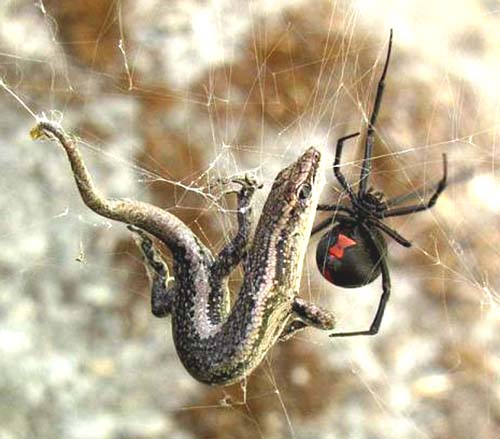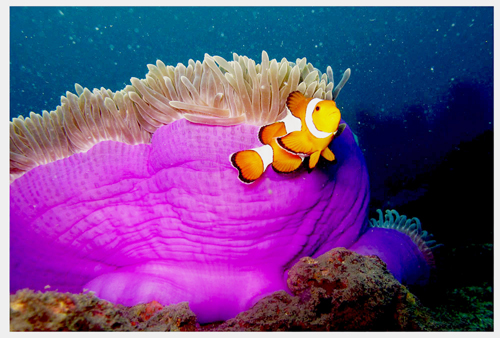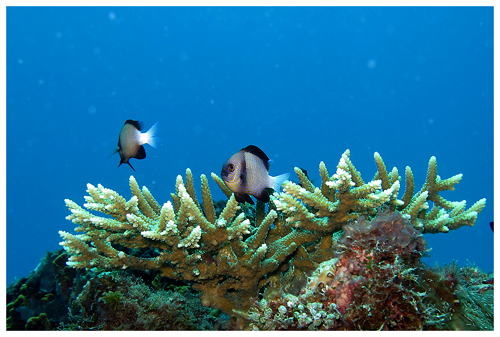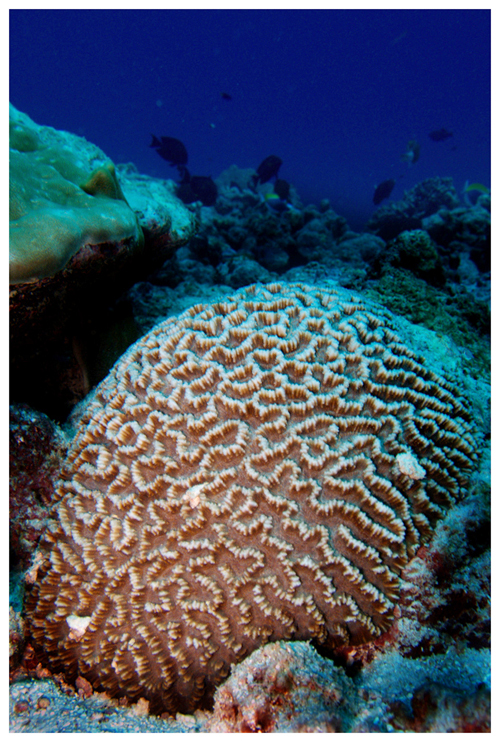- Details
- Denis Giles
- Hits: 2744

Spiders are not insects, although they belong to the same phylum of animals as insects. Spiders have four pairs of legs and two body segments, they do not have wings or antennae. Spiders belong to the class Arachnida while insects belong to the class Insecta. Spiders are closely related to scorpions, ticks and mites. There are about 37,000 of known species of spiders in the world. Spiders vary in size from the 10 inched bird-eating tarantulas of the rain forest to as small as pin point (0.37 mm) as in Patu digua, a spider of Columbia and they vary widely in colour. The Spider Wasp is the biggest predator of Spider species. The blood of a Spider is light blue in color. They are found everywhere; in soil, under rocks, on grasses, on tree branches, in caves, in your garden or even in your restrooms. Many spiders only live for one or two years, but some like tarantulas live for about 20 years.
Silk: Spiders have glands that make silk. The strongest material in the world is considered as the silk that spiders create. Scientists have not been able to recreate this design even with all the available technology that we have today. The silk is used to capture prey in elaborately woven webs, to wrap and protect eggs and as a bungee cord to move from place to place.
Venom: Spiders are carnivorous and feed on living prey. They crush the prey with processes on the pedipalps, and the chelicerae and have glands that can inject a venom. The bite of some large spiders are painful, but most species are too small to break human skin and only a few are dangerous to humans. Black widow spider is one of the poisonous species, they are nonaggressive and bite humans only in defense. Their painful bite is followed by faintness, difficulty in breathing; although the bite sometime leads to death. Spider venom are neurotoxins, which affects the victims nervous system, typically resulting in paralysis. Some injects cytotoxins that affect the cell tissue. There were about 100 reliably reported deaths from spider bites.
Benefits to humans: Cooked tarantula spiders are considered a delicacy in Cambodia, where the venom gland and outer hairs are removed before cooking. Most spiders are helpful to humans by killing insects harmful to animals and plants. Spider venoms are found to be less polluting alternative to conventional pesticides as they are deadly to insects. Possible medical uses for spider venoms are being investigated for the treatment of cardiac arrhythmia, Alzheimer's disease and strokes. Fine transparent spider silk fibers are used by scientists working on optical communications to introduce minute diffraction patterns over propagating N-slit interferometric signals.
Contributed by: Dr. J. Benjamin Franklin, Scientist, NIOT, Port Blair.
- Details
- Denis Giles
- Hits: 1851

A famous Disney animation movie introduced the underwater world through a movie, Finding Nemo. The movie was well received and Nemo, the clown fish, received a lot of attention, not only with children but also with grown ups .
The habitat of Nemo is coral reef ecosystem, which is a colony of individual corals. The coral animal or polyp has a simple gut that opens at one end and a mouth surrounded by tentacles. These tentacles live in association with algae called zooxanthallae. They form a calcium carbonate structure, which is the main skeleton of the reefs. Corals thrive in bright, sunlit, nutrient-rich areas and provide habitat for thousands of organisms including fish and a variety of other marine life—from large mammals to tiny shells.

However over the recent years this ecosystem has been threatened due to destructive fishing practices, pollution and their sensitivity to global climate change. In Andaman and Nicobar islands, the reefs have a history of suffering. In 2004 there was a massive tsunami, which impacted the reefs. At some sites, coral reefs were broken into chunks while in others, suffocated by piles of mud and debris. Just when reefs had begun to recover, they were affected by yet another natural disaster—the bleaching of 2010.
The bleaching or whitening of corals occurs when there is sudden increase in sea-surface temperature. Coral animals are sensitive to temperature changes and require warm water between 25-27° C to thrive. When temperature increases, there is a breakdown of the symbiotic relationship between corals and algae resulting in death of the reefs.
Certain areas got heavily affected whereas few reef areas survived the bleaching. Why a few areas survived, while others got affected is interesting; and understanding the processes and mechanism of bleaching could help managers to concentrate their efforts on areas that are naturally resilient to bleaching.

Currently, Andaman Nicobar Islands’ Environmental Team (ANET) runs a project supported by Wildlife Conservation Society is conducting in-depth research to unravel the mystery of why a few reefs survived this bleaching event while the others didn’t. By conducting a series of reef surveys and comparing the various levels of destruction and resilience, we will be able to get a glimpse into this complex event. This will allow us to understand Nemo’s habitat – the coral reef system better so that we can begin taking steps to protect it. While this may not directly result in reversing the effects caused by the bleaching, it can certainly lead to better resource planning and management such as, reducing the man made impacts like habitat destruction, pollution, overfishing and improper disposal of garbage, giving hope to the future of the reefs.
- Vardhan Patankar
- Details
- Bency Joy
- Hits: 1527
We all entered into the NEW YEAR 2013.The first day of the year is perhaps the only day that celebrates the passage of time and that’s why most of us became introspective as the final seconds of the year tick away.
- Details
- Denis Giles
- Hits: 1444
Food plays an important role in maintaining the nation as it produces a healthy citizen for her protection mentally, and physically. Due to poor economic background, many students do not consume the proper nutritious food. To make it available, the central and state governments took initiative to introduce the mid-day meal scheme in the schools. It is appreciable work as to serve the humanity a fist of rice with dal. This scheme helps the motivated child to learn beyond the poor economy.
Many schools implemented this scheme and running successfully. It is also need to ensure how many children are really consuming the food in his/ her school. They avoid the food because of improper cooking of food, or they found worms or stone-grains in the food in the past. Improper cooking, worms and stone-grains not only will make the food waste but also reduce the attendance of the students, if consumed.
Students from above poverty-line (APL), bring food from home or hotels for lunch. They normally bring noodles, poorie, biscuits and other junk/fast food. It is the responsibility of the student to consume healthy food. Parents have to ensure their children eat healthy food and do not skip break-fast, lunch and dinner no matter whether both parents are office-going.
The school-going children should consume balanced-diet containing protein, carbohydrate, fat and other vitamins & minerals in the requisite amount. Students especially in the adolescence period i.e., from 11 to 19 years should include all the nutrients in their diet. During this period, the body grows enormously, metabolic rate is also high. High energy must be provided for the body to perform its function properly. When the physique is fit, the children become mentally also fit.
Starchy food like cakes, biscuits, noodles and other foods made of maida flour creates craving for food and stomach problem. Food rich of fiber like roti/chapatti, grains, cereals, pulses, dates, vegetables help in bowl movement and provide the requisite nutrition also to the growing children. So, these must be included in their diet.
Water consumption is also founded to be a major issue in the children. Lots of stomach complaints could also found in the schools. Water helps in regulating the acid-base level and smooth bowl movement in the body. Those who consume no or less water, these students come with stomach-ache, gastric problems in the school. School must make available the pure drinking water facility. At least 2 liters of water must be taken daily.
There is no doubt of creating a healthy citizen for our country if we ensure proper, healthy food for our growing children.
L. Elaya Raja, Science Teacher, VKZPV, Diglipur.
- Details
- Shamsher Bahadur Singh Deol
- Hits: 1818
Bijli Prasad, aged 42 years, was standing on a slope at Hut Bay in the island of Little Andaman steadily consuming the breakfast laid before him, when the ground shifted below his sturdy feet with a violent to and fro movement. His immense weight and high centre of gravity made him stumble forward. He fell heavily on his skull and died, perhaps the first victim of the earthquake in the islands. What made him trip was the iron chain that bound his foot to a tree trunk, intended to restrict erratic actions that may stem from sexual frustration.